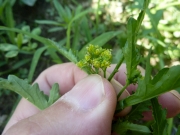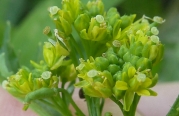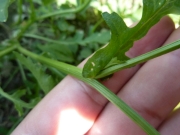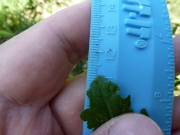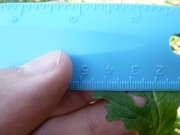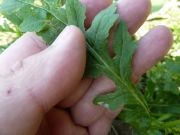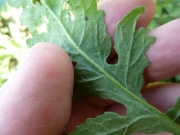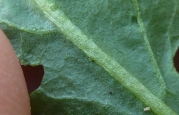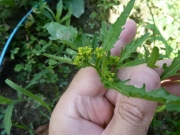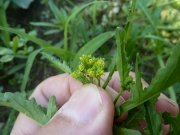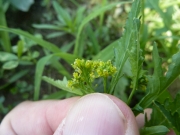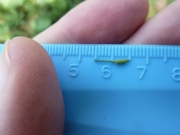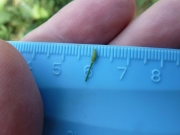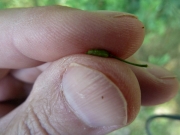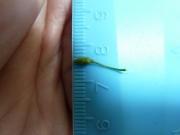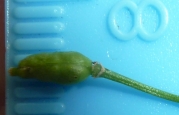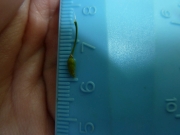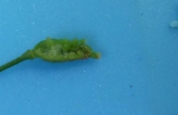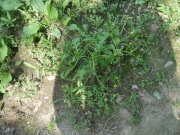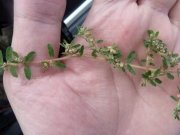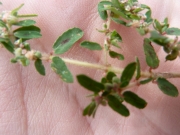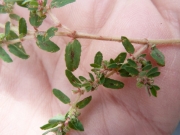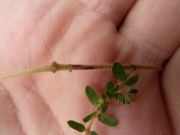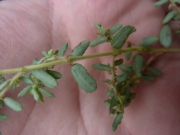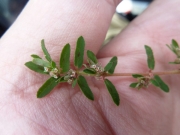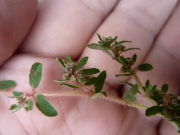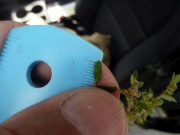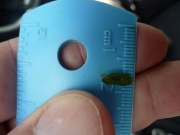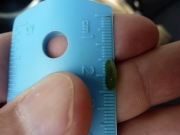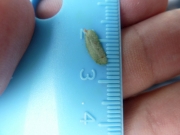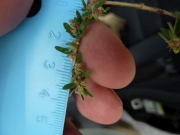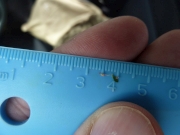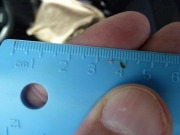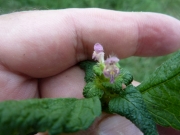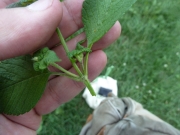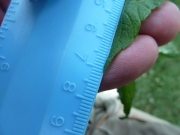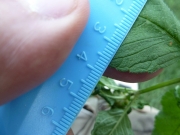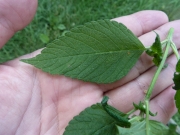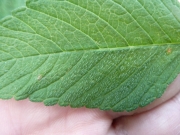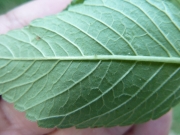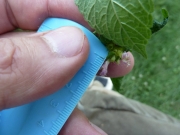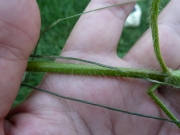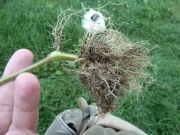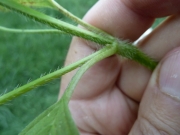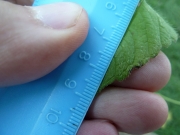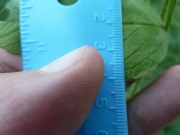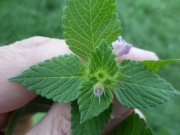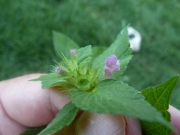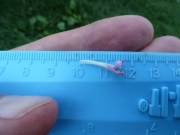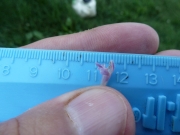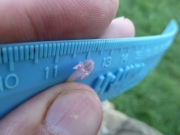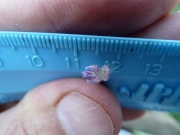Transformational Gardening
July 2012 Foraging Experiences
(Back to:
June 2012 Foraging Experiences)
(Forward to:
August 2012 Foraging Experiences)
July 2, 2012
Christmas Fern (Polystichum acrostichoides)
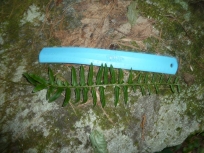
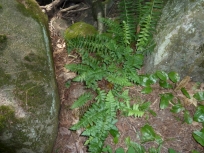 Merry Christmas Fern! It is a member of the Holly Fern genus (Polystichum).
Some simple keys to identify this fern:
Merry Christmas Fern! It is a member of the Holly Fern genus (Polystichum).
Some simple keys to identify this fern:
- Leathery leaves.
- Pinnately compound.
- Pinnule (leafule) with triangular auricle at base.
- Fertile pinnae (leaflets) on upper part of frond (leaf) and are much smaller than
lower, non-fertile pinnae.
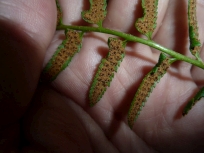
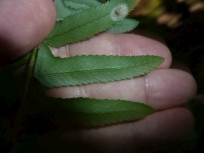
- Sori covers fertile pinnae.
- Two lowest pinnae often down-pointed.
- Hairs/spines at tip of pinnule teeth.
New York Fern (Parathelypteris noveboracensis) (Also known as:
Thelypteris noveboracensis)
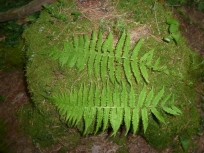
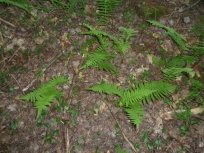 At first I thought this might be Eastern Hay-Scented Fern (Dennstaedtia punctilobula)
since it is a green-yellow color and did not grow in circular clumps. But Eastern
Hay-Scented Fern is bipinnate-pinnatifid and the sparse and very small, cup-shaped sori
are found on the sinus margins. New York Fern is bipinnate and the sori are more common,
much larger, horseshoe-shaped and not on the sinuses of the margins. New York Fern has
a long, hairy rachis (midrib of leaf blade) while Eastern Hay-Scented Fern has shorter
and fewer hairs.
At first I thought this might be Eastern Hay-Scented Fern (Dennstaedtia punctilobula)
since it is a green-yellow color and did not grow in circular clumps. But Eastern
Hay-Scented Fern is bipinnate-pinnatifid and the sparse and very small, cup-shaped sori
are found on the sinus margins. New York Fern is bipinnate and the sori are more common,
much larger, horseshoe-shaped and not on the sinuses of the margins. New York Fern has
a long, hairy rachis (midrib of leaf blade) while Eastern Hay-Scented Fern has shorter
and fewer hairs.
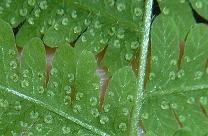
 Some keys to identifying this fern include:
Some keys to identifying this fern include:
- Yellow-Green (like Eastern Hay-Scented Fern)
- Long-tapering, sometimes wavy pinnae (leaflets).
- Horseshoe-shaped sori near margins.
- Bipinnate.
- Lower pinnae (leaflets) gradually getting smaller and then very small down the
main stem (not far from the ground).
July 3, 2012
Pin Cherry (Prunus pensylvanica)

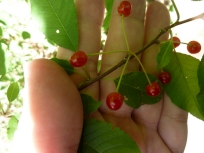 I knew that there was a bunch of pin cherry trees growing along the path, but I had to wait until
the fruit appeared to be sure. There are quite a number of New England plants (19) in the
Prunus genus. Much more than Pin Cherry, Choke Cherry (Prunus virginiana) and
Black Cherry (Prunus serotina). In a few days, I'll be having my fill of Pin Cherry!
Key:
I knew that there was a bunch of pin cherry trees growing along the path, but I had to wait until
the fruit appeared to be sure. There are quite a number of New England plants (19) in the
Prunus genus. Much more than Pin Cherry, Choke Cherry (Prunus virginiana) and
Black Cherry (Prunus serotina). In a few days, I'll be having my fill of Pin Cherry!
Key:
- Flowers and fruits borne on pedicels.
- Drupes (fruit) not grooved and not glaucous.
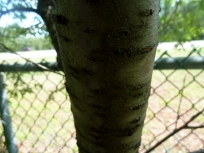
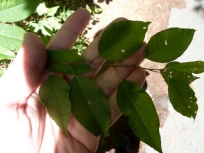
- Inflorescence a fascicle with 2-10 flowers (not a raceme).
- Leaf blade with teeth that possess a gland at the tip. Note: The gland is deciduous
at maturity. The leaf gland scar can be seen in the closeup in the last picture below.
- Leaf blades lanceolate, elliptic, elliptic-ovate, or elliptic-obovate (not broadly-rounded
or suborbicular). Branchlets lacking glandular hairs. 2-5 flowered fascicle.
- Drupes 5-7 mm in diameter.
July 4, 2012
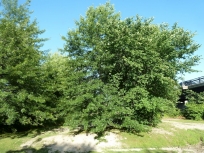
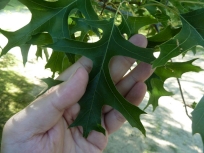 I wish there was is easier way to tell the difference between Scarlet Oak (Quercus coccinea)
and Black Oak (Quercus velutina) without looking at the terminal winter bud. Black Oak has
a very long (7-10 mm) terminal Winter bud. There probably is an easier way to tell the difference,
but I don’t know it yet.
I wish there was is easier way to tell the difference between Scarlet Oak (Quercus coccinea)
and Black Oak (Quercus velutina) without looking at the terminal winter bud. Black Oak has
a very long (7-10 mm) terminal Winter bud. There probably is an easier way to tell the difference,
but I don’t know it yet.
There are only 5 oaks in New England that have leaves with bristle on the tips and lobes:
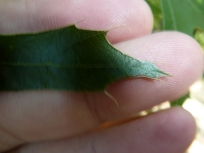
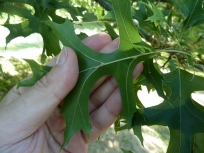
- Bear Oak/Scrub Oak (Quercus ilicifolia): Short to tall shrubs (up to 16 feet).
Distal leaf lobes long and spreading. Proximal leave lobes much shorter. Short (10-25 mm) petiole.
- Red Oak (Quercus rubra): Sinuses of leaf usually extending less than 1/2
the distance from the tip of the lobes to the midrib.
- Black Oak (Quercus velutina): Long (7-10 mm) terminal winter bud.
- Pin Oak (Quercus palustris): Terminal winter bud is glabrous or with just a few
hairs at the apex. The bud tends to be more pointed than Scarlet Oak bud. Rounded to obscurely
angled in cross-section. Inner bark is pinkish.
- Scarlet Oak (Quercus coccinea): Terminal winter bud is hairy at the apex. Bud
is 5-angled in cross-section. Inner bark is orangish pink.
I thought it might be Pin Oak, but it is not found in New Hampshire (normally) and a closeup
of the bud showed that the apex was hairy (see picture below).
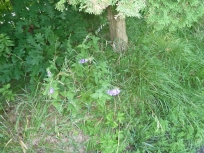
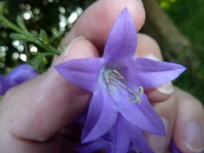 A very interesting find. I had never seen any bellflowers before. According to the
New England Wildflower Society web page, “It is edible. The leaves and young shoots
are high in vitamin C and mild in flavor, and the roots are edible raw or cooked.” Key:
A very interesting find. I had never seen any bellflowers before. According to the
New England Wildflower Society web page, “It is edible. The leaves and young shoots
are high in vitamin C and mild in flavor, and the roots are edible raw or cooked.” Key:
- Style included with the corolla to reaching the tips of the corolla lobes.
- Corolla 10-55 mm long.
- Calyx without appendages between the lobes.
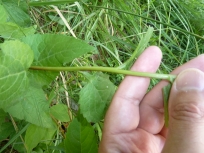
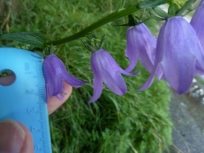
- Flowers with pedicels (stems).
- Calyx lobes lanceolate to triangular or oblong. Stem leaves not linear to
narrow-lanceolate.
- Stem leaf blades lanceolate to ovate, cordate-ovate, or triangular-ovate.
- Corolla not broadly rotate-campanulate (nearly circular in outline).
- Calyx lobes spreading to reflexed during flowering. Inflorescence an elongate,
raceme with flowers tending to one side of the stem.
July 6, 2012
White Baneberry (Poisonous) ☠
(Actaea pachypoda)
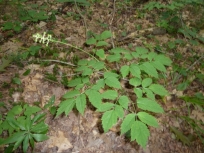
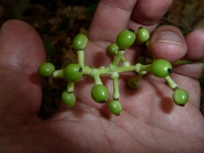
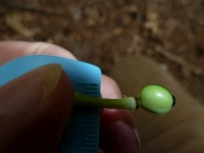
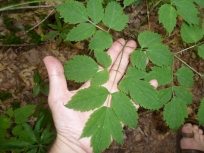
Red Oak (Quercus rubra)
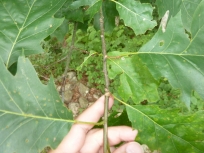
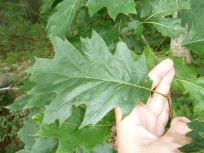
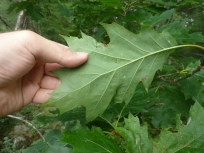
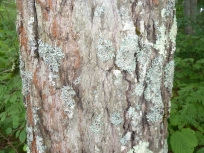
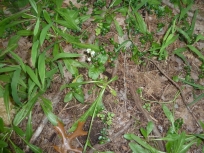
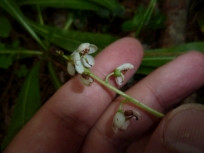
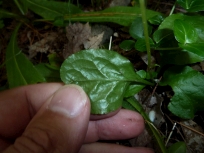
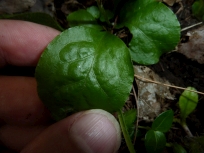
Spotted Knapweed (Centaurea stoebe)
(Also known as: Centaurea stoebe ssp. micranthos)
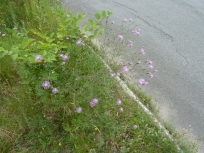
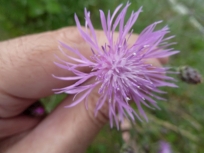
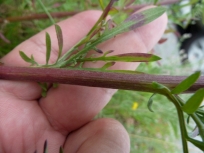
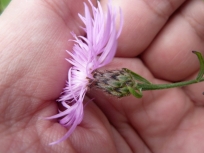
July 7, 2012
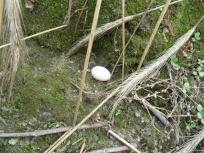 A little turtle egg on the trail.
A little turtle egg on the trail.
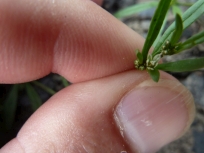
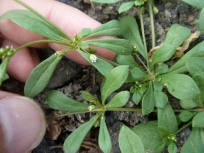
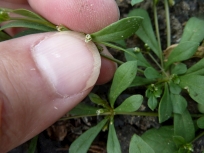
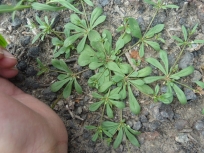
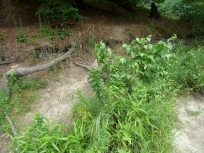

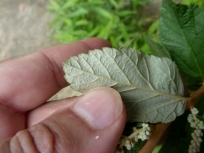
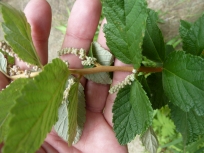
July 9, 2012
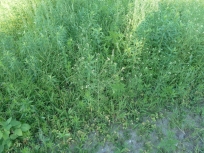

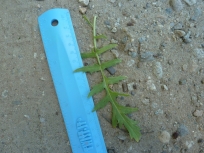

July 10, 2012
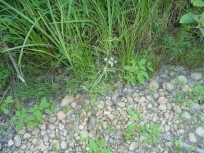
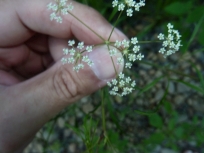
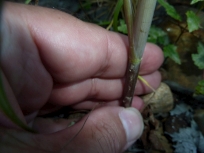
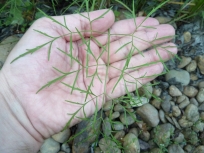
July 14, 2012
Dewdrop (Robin Runaway)
(Dalibarda repens) (Also knowns as: Rubus dalibarda)
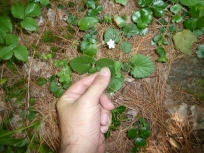
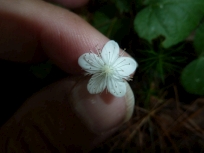
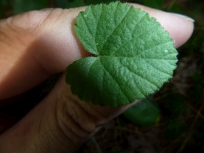
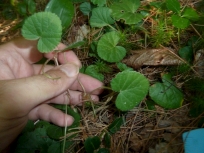
July 15, 2012
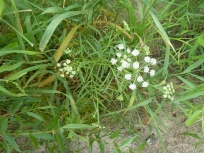
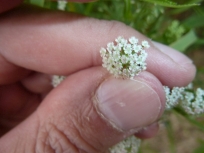
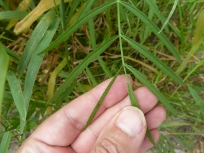
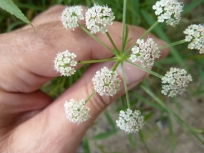
July 17, 2012
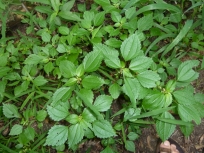
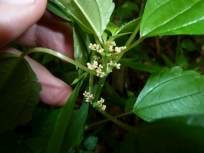
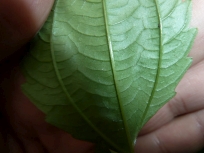
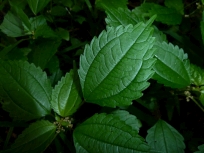

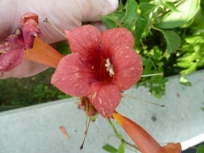
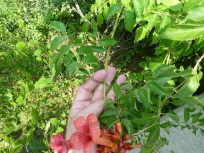
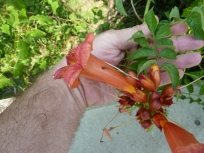
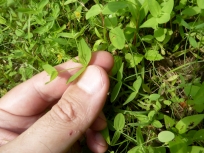
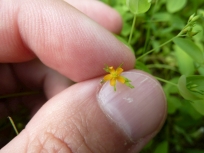 This little yellow flower looked to me like a St. John’s Wort (for some reason), but
IDing the actual species was difficult. An in focus closeup of the flower (including the
styles) would have helped. One thing to remember is that the flower petals of Dwarf
St. John’s Wort are yellow with a strong orange tinge. Key:
This little yellow flower looked to me like a St. John’s Wort (for some reason), but
IDing the actual species was difficult. An in focus closeup of the flower (including the
styles) would have helped. One thing to remember is that the flower petals of Dwarf
St. John’s Wort are yellow with a strong orange tinge. Key:
- Flowers with 5 sepals and 5 petals.
- Plants herbaceous.
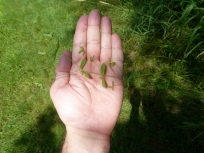
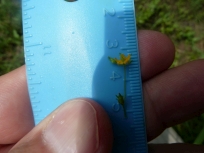
- Petals 2-12 mm long.
- Styles distinct nearly to the base and not appearing as a single beak at the summit.
- Flowers with 5-22 stamen.
- Leaf blades 3-45 mm long, 1-7 nerved (veined), spreading to ascending.
- Sepals linear to linear-lanceolate (broadest near the middle).Capsules ellipsoid,
abruptly tapered and rounded at the summit. Stems decumbent (prostrate at the base) -- I
did not see this to be the case. At this point, I was thinking it might be Greater St.
John’s Wort (Hypericum majus), but I read that Greater St. John’s Wort
flower has 14-21 stamen and this flower has much fewer than 14 stamen. Dwarf St. John’s
Wort flower has 5-16 stamen.
- Sepals acute at the apex and nearly the same length as the capsule.
July 19, 2012
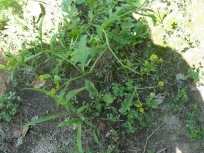
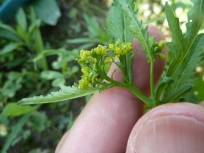 This plant was at the edge of a dry field. But the field gets flooded during
ocassional rain storms. I went through the Mustard family key several times
to first confirm that this was a Rorippa and then confirm the species. Key:
This plant was at the edge of a dry field. But the field gets flooded during
ocassional rain storms. I went through the Mustard family key several times
to first confirm that this was a Rorippa and then confirm the species. Key:
- Fruit is a silicle (up to 3 times as long as wide). Note: some of the seed pods
were slightly more than 3 times as long as wide and some were less.
- Silicle dehiscent (splits open at maturity), containing 2 to many seeds.
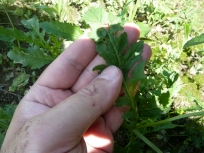

- Silicle not compressed at right angles to the septum (seed partition).
- Silicle compressed, narrower than 6 mm. Flower petals white or yellow.
- Flower petals not deeply-notched. Fruiting pedicels spreading to ascending.
- Silicle symmetrical and without tubercles (swellings of different colors and/or
textures).
- Silicle not compressed.
- Plants glabrous or pubescent with unbranched hairs.
- Principal leaf blades pinnately-lobed. Petals yellow (except in one Rorippa
species). Genus identified: Rorippa.
- Flower petals yellow or absent. Leaf blades subentire to pinnately lobed.
- Flower petals present. Fruiting pedicels 2-15 mm long.
- Flower petals 0.7-3.5 mm long, shorter than or equal to the length of the sepals.
- Silicles ovoid-obloid to broad-ovoid, 3-10 mm long. Flower petals 0.8-3.5 mm long.
Species identified: Rorippa palustris.
- Stem glabrous. Back of leaf glabrous or sparsely hirsute (coarse, somewhat stiff and
curving hairs) near the base. Variation identified: Rorippa palustris var. palustris.
July 20, 2012
Spotted Sandmat (Euphorbia maculata) (Also known as: Chamaesyce maculata)
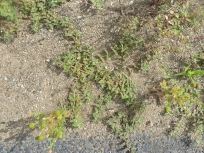
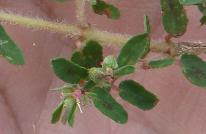
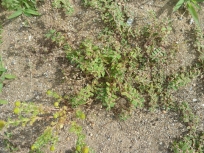
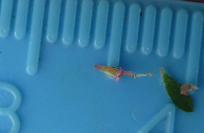
July 22, 2012
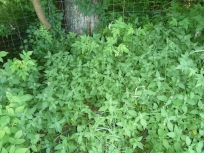
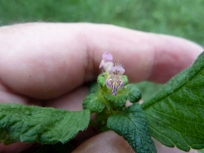
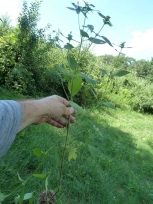




 Merry Christmas Fern! It is a member of the Holly Fern genus (Polystichum).
Some simple keys to identify this fern:
Merry Christmas Fern! It is a member of the Holly Fern genus (Polystichum).
Some simple keys to identify this fern:

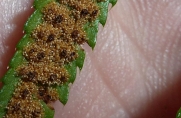
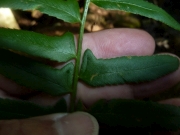
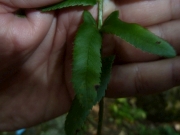
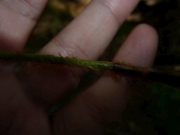

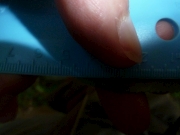
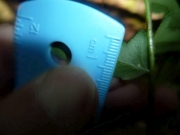
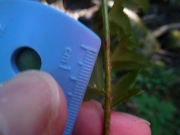
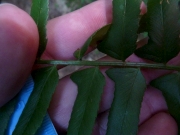

 At first I thought this might be Eastern Hay-Scented Fern (Dennstaedtia punctilobula)
since it is a green-yellow color and did not grow in circular clumps. But Eastern
Hay-Scented Fern is bipinnate-pinnatifid and the sparse and very small, cup-shaped sori
are found on the sinus margins. New York Fern is bipinnate and the sori are more common,
much larger, horseshoe-shaped and not on the sinuses of the margins. New York Fern has
a long, hairy rachis (midrib of leaf blade) while Eastern Hay-Scented Fern has shorter
and fewer hairs.
At first I thought this might be Eastern Hay-Scented Fern (Dennstaedtia punctilobula)
since it is a green-yellow color and did not grow in circular clumps. But Eastern
Hay-Scented Fern is bipinnate-pinnatifid and the sparse and very small, cup-shaped sori
are found on the sinus margins. New York Fern is bipinnate and the sori are more common,
much larger, horseshoe-shaped and not on the sinuses of the margins. New York Fern has
a long, hairy rachis (midrib of leaf blade) while Eastern Hay-Scented Fern has shorter
and fewer hairs.
 Some keys to identifying this fern include:
Some keys to identifying this fern include: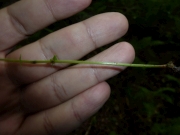
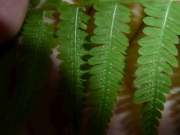
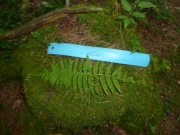

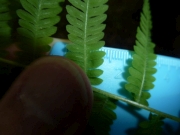
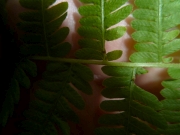
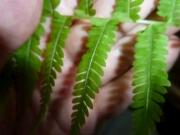
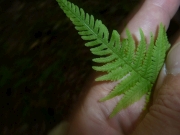
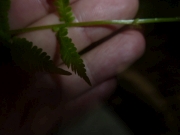
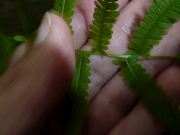

 I knew that there was a bunch of pin cherry trees growing along the path, but I had to wait until
the fruit appeared to be sure. There are quite a number of New England plants (19) in the
Prunus genus. Much more than Pin Cherry, Choke Cherry (Prunus virginiana) and
Black Cherry (Prunus serotina). In a few days, I'll be having my fill of Pin Cherry!
Key:
I knew that there was a bunch of pin cherry trees growing along the path, but I had to wait until
the fruit appeared to be sure. There are quite a number of New England plants (19) in the
Prunus genus. Much more than Pin Cherry, Choke Cherry (Prunus virginiana) and
Black Cherry (Prunus serotina). In a few days, I'll be having my fill of Pin Cherry!
Key:

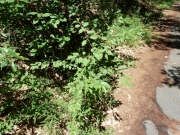
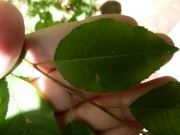
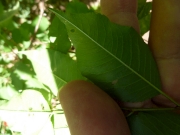
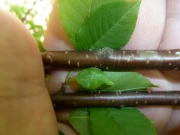
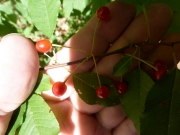
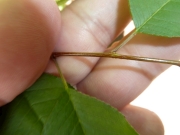
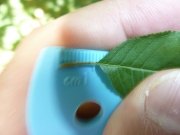
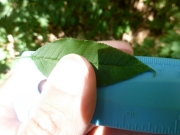
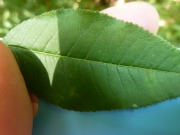

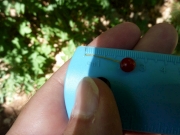
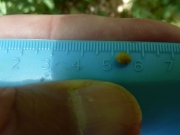
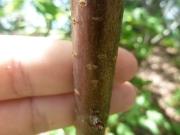
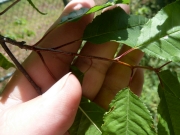
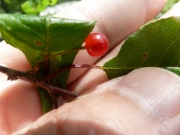
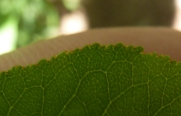

 I wish there was is easier way to tell the difference between Scarlet Oak (Quercus coccinea)
and Black Oak (Quercus velutina) without looking at the terminal winter bud. Black Oak has
a very long (7-10 mm) terminal Winter bud. There probably is an easier way to tell the difference,
but I don’t know it yet.
I wish there was is easier way to tell the difference between Scarlet Oak (Quercus coccinea)
and Black Oak (Quercus velutina) without looking at the terminal winter bud. Black Oak has
a very long (7-10 mm) terminal Winter bud. There probably is an easier way to tell the difference,
but I don’t know it yet.

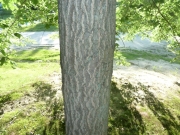
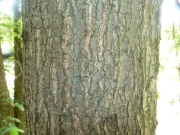
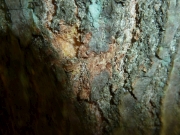
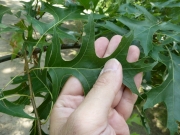

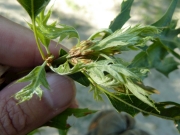
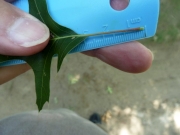
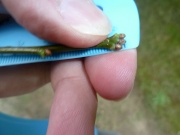
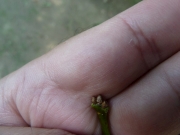
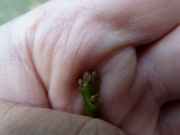
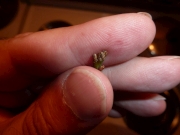
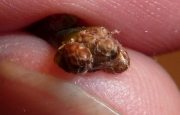
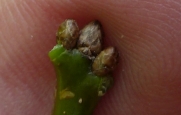
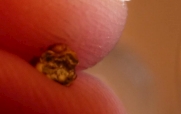
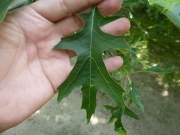
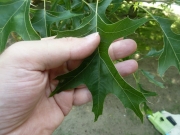
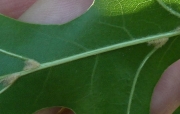

 A very interesting find. I had never seen any bellflowers before. According to the
New England Wildflower Society web page, “It is edible. The leaves and young shoots
are high in vitamin C and mild in flavor, and the roots are edible raw or cooked.” Key:
A very interesting find. I had never seen any bellflowers before. According to the
New England Wildflower Society web page, “It is edible. The leaves and young shoots
are high in vitamin C and mild in flavor, and the roots are edible raw or cooked.” Key:

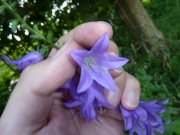
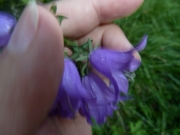
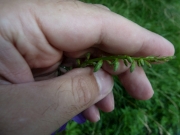
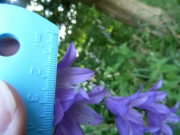
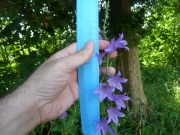
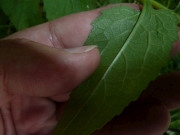
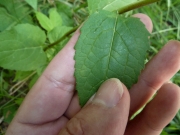
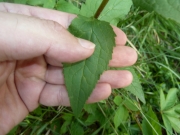
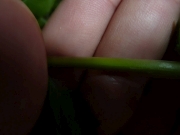
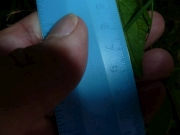
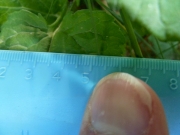
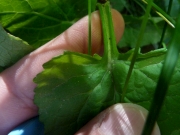




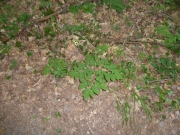
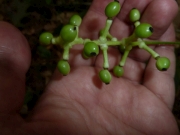
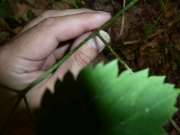
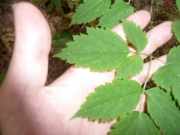

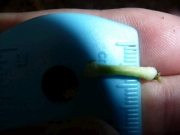
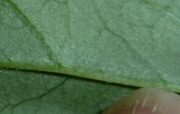
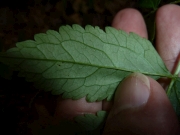




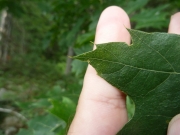
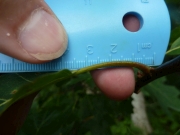
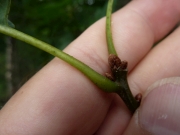
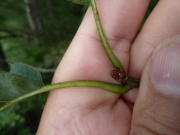
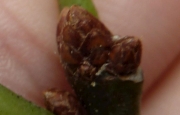
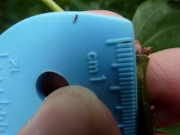
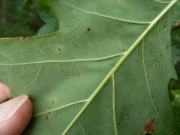
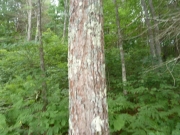





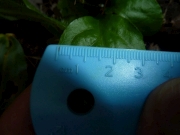
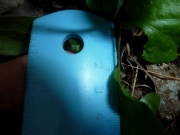
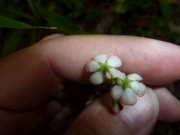
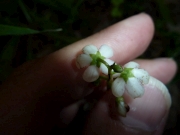




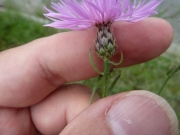

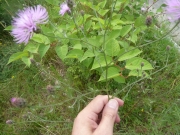
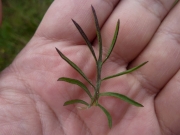
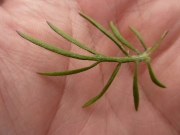
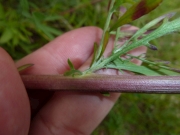
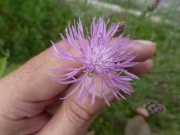
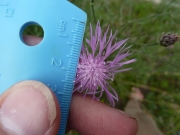
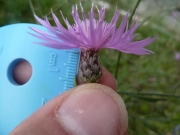
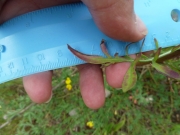
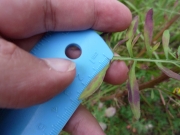
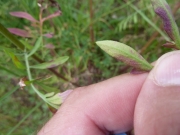
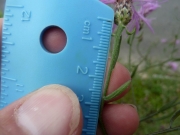
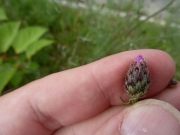
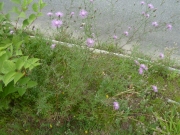
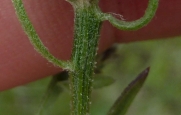
 A little turtle egg on the trail.
A little turtle egg on the trail.



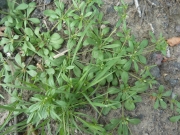
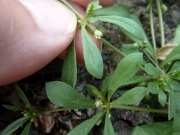
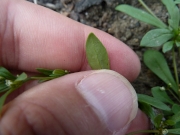




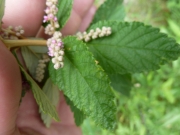
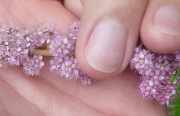




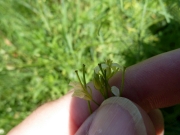
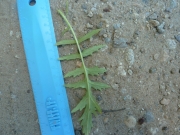
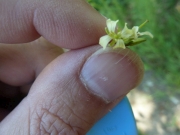
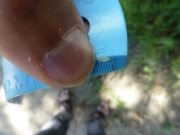
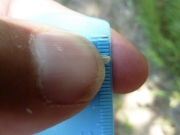
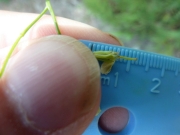

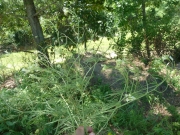
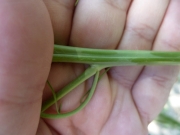
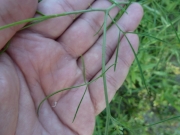
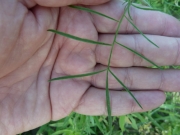
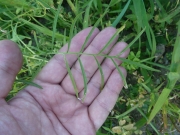
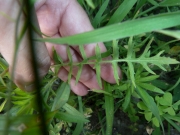
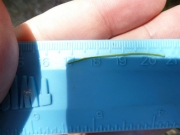
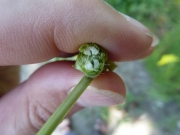
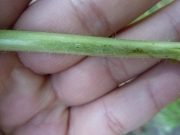
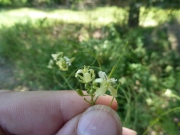
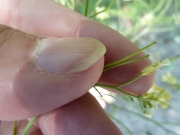
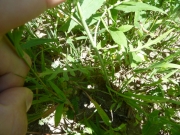
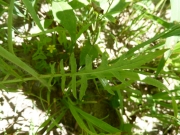
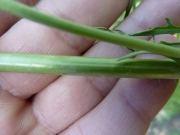
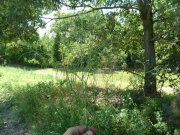




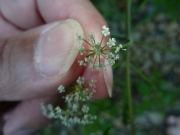
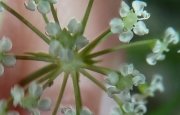
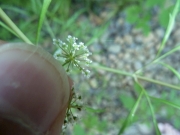
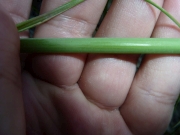
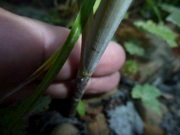
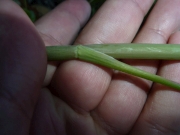
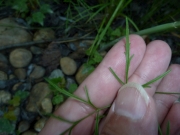
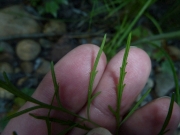
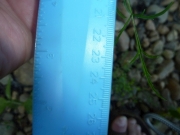
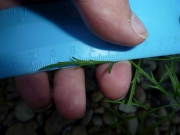
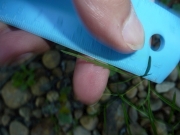
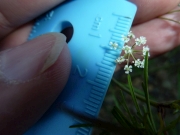

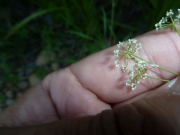
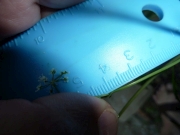
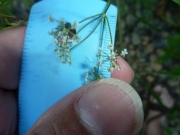




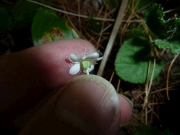
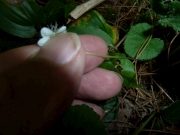
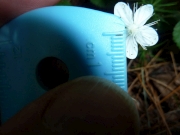
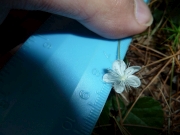
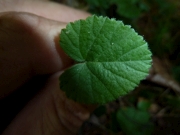
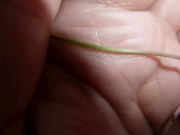
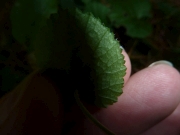
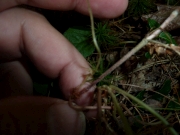
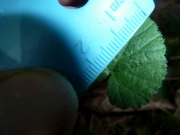
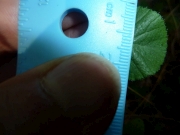
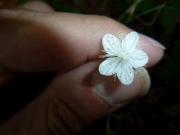




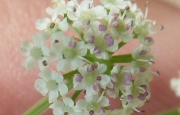
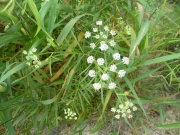
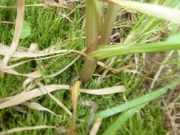
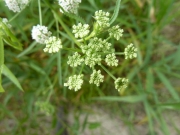
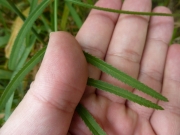
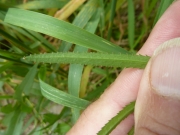
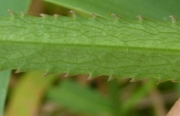
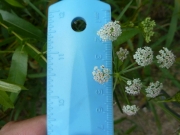

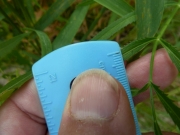
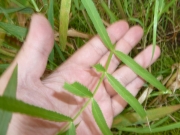
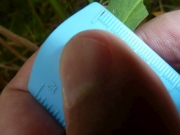
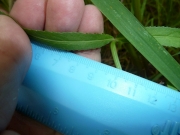
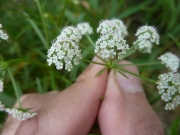
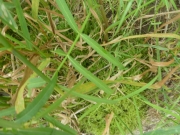
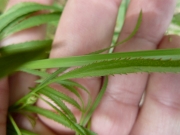





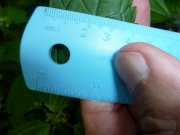
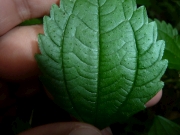
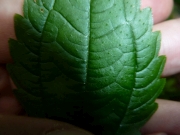
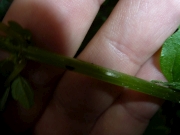
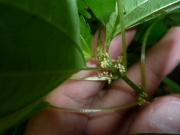
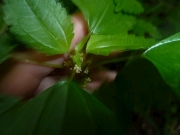
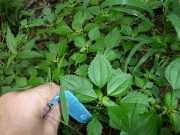
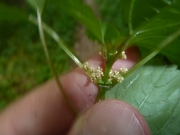
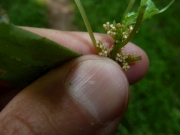
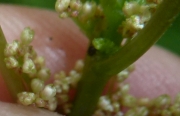
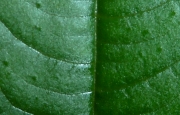




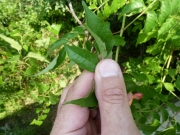
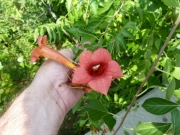
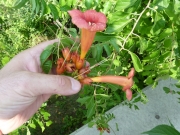
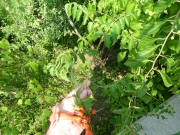
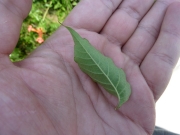
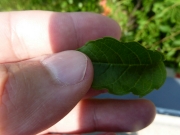
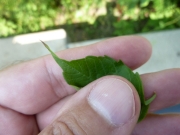
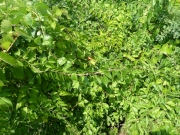

 This little yellow flower looked to me like a St. John’s Wort (for some reason), but
IDing the actual species was difficult. An in focus closeup of the flower (including the
styles) would have helped. One thing to remember is that the flower petals of Dwarf
St. John’s Wort are yellow with a strong orange tinge. Key:
This little yellow flower looked to me like a St. John’s Wort (for some reason), but
IDing the actual species was difficult. An in focus closeup of the flower (including the
styles) would have helped. One thing to remember is that the flower petals of Dwarf
St. John’s Wort are yellow with a strong orange tinge. Key:

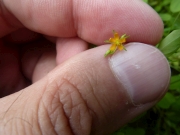
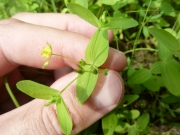
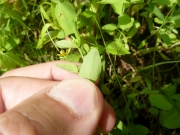
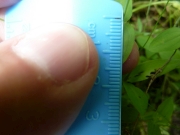
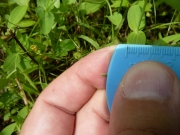
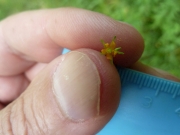
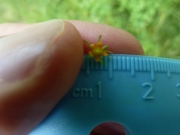
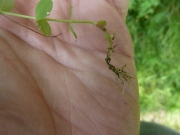
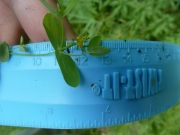
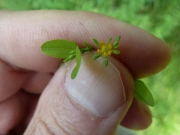
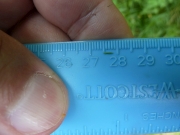
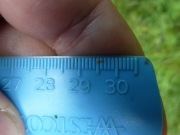
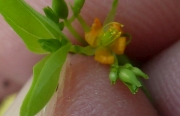
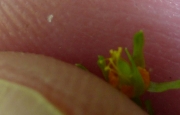
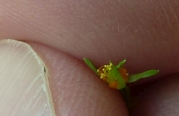
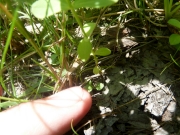
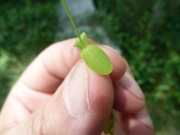
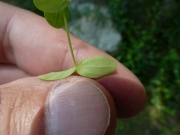
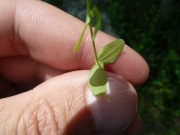
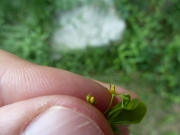

 This plant was at the edge of a dry field. But the field gets flooded during
ocassional rain storms. I went through the Mustard family key several times
to first confirm that this was a Rorippa and then confirm the species. Key:
This plant was at the edge of a dry field. But the field gets flooded during
ocassional rain storms. I went through the Mustard family key several times
to first confirm that this was a Rorippa and then confirm the species. Key:

